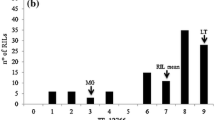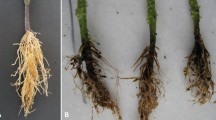Summary
The contribution of introgressed regions derived from wild species to the genetic variation within the species of Lycopersicon esculentum was investigated by comparing the RFLP patterns of 2 introgression-free, obsolete cultivars (‘Moneymaker’ and ‘Premier’) and a modern cultivar (‘Sonatine’) that carries at least 5 introgressed resistance genes. In this analysis 195 mapped nuclear markers were used in combination with 6 restriction enzymes. Among the 1170 probe-enzyme combinations tested, only 3 showed a polymorphism between the 2 introgression-free cultivars. On the other hand 24 probe-enzyme combinations were found to exhibit polymorphisms between ‘Moneymaker’ and ‘Sonatine’. These represented ten polymorphic loci distributed among 5 linkage groups on chromosomes 1, 3, 4, 6, and 9.
On the assumption that most of the polymorphic loci corresponded to introgressed chromosome segments of wild species carrying resistance genes, linkages between these loci and the component resistance genes were examined by RFLP analysis of pairs of near-isogenic lines differing only for one particular resistance gene, and a variety of commercial cultivars having different resistance gene compositions. Two of the polymorphic linkage groups could thus be ascribed to resistance genes whose map positions were already known: Cf2 on chromosome 6 and Tm2a on chromosome 9, whereas another marker, TG301 on chromosome 1, could be assigned to the Cladosporium fulvum resistance gene Cf9 with a hitherto disputable map position. By linkage analysis of a segregating F2 population the genetic distance between the Cf9 gene and the marker TG301 was estimated at 5.5 ± 2.3 cM.
Similar content being viewed by others
References
Allard RW (1956) Formulas and tables to facilitate the calculaion of recombination values in heredity. Hilgardia 24:235–278
Behare J, Laterrot H, Sarfatti M, Zamir D (1991) RFLP mapping of the Stemphylium resistance gene in tomato. Mol Plant-Microb Interact 4:489–492
Boukema IW, den Nijs APM (1984) Lycopersicon peruvianum, a valuable source of genetic variation for tomato breeders, but difficult to exploit. In: Synopses Eucarpia Meeting of the Tomato Working Group. Wageningen, pp 107–112
De Wit PJGM, Spikman G (1982) Evidence of the occurrence of race and cultivar-specific elicitors of necrosis in intercellular fluids of compatible interactions of Cladosporium fulvum and tomato. Physiol Plant Pathol 21:1–11
De Wit PJGM, Toma IMJ, Joosten MHAJ (1988) Race-specific elicitors and pathogenicity factors in the Cladosporium fulvum — tomato interaction. In: Keen Nt, Kosuge T, Walling LL (eds) Physiology and biochemistry of plant-microbial interactions. Am Soc Plant Physiol, pp 111–119
Gerlagh M, Lindhout WH, Vos I (1989) Allelic test proves genes Cf4 and Cf8 for resistance to Cladosporium fulvum (Fulvia fulvum) on tomato to be undistinguishable. Neth J Plant Pathol 95:357–359
Hall TJ (1980) Resistance at the Tm2 locus in the tomato to tomato mosaic virus. Euphytica 29:189–197
Helentjaris T, King G, Slocum M, Siedenstrang M, Wegmann S, (1985) Restriction fragment polymorphisms as probes for plant diversity and their development as tools for applied plant breeding. Plant Mol Biol 5:109–118
Hubbeling N (1978) Breakdown of resistance of the Cf5 gene in tomato by another new race of Fulvia fulva. Med. Fac Landbouw Rijksuniv Genet 43:891–894
Jones DA, Dickinson MJ, Jones JDG (1991) Genetic locations of the Cf-2,Cf-4,Cf-5 and Cf-9 genes for resistance to Cladosporium fulvum. Tomato Genet Coop Rep 41:22
Kanwar JS, Kerr EA, Harney PM (1980) Linkage of Cf-1 to Cf-11 genes for resistance to tomato leaf mold, Cladosporium fulvum Cke. Tomato Genet Coop Rep 30:20–21
Kerr EA, Bailey DL, (1964) Resistance to Cladosporium fulvum Cke. obtained from wild species of tomato. Can J Bot 42:1541–1553
Klein-Lankhorst R, Rietveld P, Machiels B, Verkerk R, Weide R, Gebhardt C, Koornneef M, Zabel P (1991a) RFLP markers linked to the root knot nematode resistance gene Mi in tomato. Theor Appl Genet 81:661–667
Klein-Lankhorst RM, Vermunt A, Weide R, Liharska T, Zabel P (1991b) Isolation of molecular makers for tomato (L. esculentum) using random amplified polymorphic DNA (RAPD). Theor Appl Genet 83:108–114
Langford AN (1937) The parasitism of Cladosporium fulvum Cooke and the genetics of resistance to it. Can J Res Sect C 15:108–128
Laterrot H (1976) Localisation chromosomique de I2 chez la tomate controlant la resistance au patotype 2 de Fusarium oxysporum f. lycopersici. Ann Amél Plant 26:485–491
Laterrot H, Clergeau M, (1979) Determination des pathotypes de Fulvia fulva (= Cladosporium fulvum) present sur tomate dans les serres franccaises. Ann Amél Plant 29:447–462
Lindhout P, Verkerk R, Mullaart E, Uitterlinden A, Vijg J (1991) Cultivar identification of tomato by DNA analysis with repetitive probes. Tomato Genet Coop Rep 41:15
Martin GB, Williams JGK, Tanksley SD (1991) Rapid identification of markers linked to a Pseudomonas resistance gene in tomato by using random primers and near-isogenic lines. Proc Natl Acad Sci USA 88:2336–2340
Miller JC, Tanksley SD (1990) RFLP analysis of phylogenetic relationships and genetic variation in the genus Lycopersicon. Theor Appl Genet 80:437–448
Nienhuis J, Helentjaris T, Slocum B, Ruggero B, Schaefer A (1987) Restriction fragment length polymorphism analysis of loci associated with insect resistance in tomato. Crop Sci 27:797–803
Osborn TC, Alexander D, Fobes JF (1987) Identification of restriction fragment length polymorphisms linked to genes controlling soluble solids content in tomato fruit. Theor Appl Genet 73:350–356
Paterson AH, Damon S, Hewitt JD, Zamir D, Rabinowitch HD, Lincoln SE, Lander ES, Tanksley SD (1991) Mendelian factors underlying quantitative traits in tomato: Comparison across species, generations, and environments. Genetics 127:181–197
Patterson BD (1988) Genes for cold resistance from wild tomatoes. Hortic Sci 23:794–947
Rick CM (1982) The potential of exotic germplasm for tomato improvement. In: Vasil IK, Scowcroft WR, Freys KJ (eds) Plant improvement and somatic cell genetics. Academic Press, New York, pp 1–28
Rick CM (1991) Tomato paste: A concentrated review of genetic highlights from the beginnings to the advents of molecular genetics. Genetics 128:1–5
Sarfatti M, Katan J, Fluhr R, Zamir D (1989) An RFLP marker in tomato linked to the Fusarium oxysporum resistance gene I2. Theor Appl Genet 78:755–759
Sarfatti M, Abu-Abied M, Katan J, Zamir D (1991) RFLP mapping of II a new locus in tomato conferring resistance against Fusarium oxysporum f.sp. lycopersici race 1. Theor Appl Genet 82:22–26
Tanksley SD, Mutschler MA (1990) Linkage map of the tomato (Lycopersicon esculentum) (2N = 24). In: O'Brian SJ (ed) Genetic maps; locus maps of complex genomes. Cold Spring Harbor Laboratory Press, Cold Spring Harbor, N.Y., 6.3–6.15
Tanksley SD, Young ND, Paterson AH, Bonierbale M (1989) RFLP mapping in plant breeding: new tools for an old science. Bio/technology 7:257–263
Welsh J, McClelland M (1990) Fingerprinting genomes using PCR with arbitrary primers. Nucleic Acids Res 18:7213–7218
Williams JGK, Kubelik AR, Livak KJ, Rafalski JA, Tingey SV (1990) DNA polymorphisms amplified by arbitrary primers are useful as genetic markers. Nucleic Acids Res 18:6531–6535
Young ND, Tanksley SD (1989) RFLP analysis of the size of chromosomal segments retained around the Tm-2 locus of tomato during backcross breeding. Theor Appl Genet 77:353–359
Young ND, Zamir D, Ganal MW, Tanksley SD (1988) Use of isogenic lines and simultaneous probing to identify DNA markers tightly linked to the Tm-2a gene in tomato. Genetics 120:559–585
Author information
Authors and Affiliations
Additional information
Communicated by F. Salamini
Rights and permissions
About this article
Cite this article
van der Beek, J.G., Verkerk, R., Zabel, P. et al. Mapping strategy for resistance genes in tomato based on RFLPs between cultivars: Cf9 (resistance to Cladosporium fulvum) on chromosome 1. Theoret. Appl. Genetics 84, 106–112 (1992). https://doi.org/10.1007/BF00223988
Received:
Accepted:
Issue Date:
DOI: https://doi.org/10.1007/BF00223988




